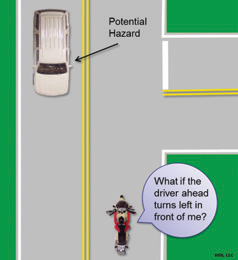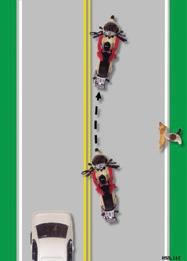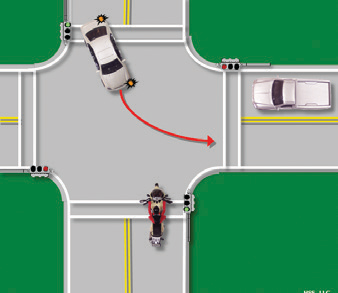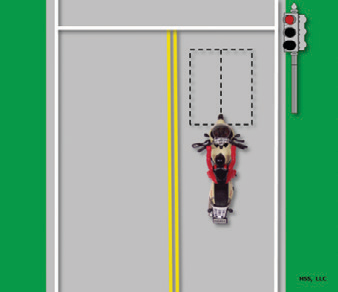
All Locations Closed for New Years Day 2026
All locations are closed Thurs 1 Jan, 2026 for the holiday.
Section 5.2 - 5.4
Evaluate

Once you have identified the hazard(s), the next step is to quickly determine if they could affect you. Ask yourself, “what if?”
Think about how hazards can interact to create risk for you. Anticipate potential problems and have a plan to reduce or eliminate the risk. Think about your time and space requirements in order to maintain a margin of safety. You must leave yourself time and space to react if a dangerous situation occurs.
Execute

Carry out your decision. What are you going to do and how are you going to do it?
To create more space and minimize harm from any hazard:
- Adjust your position and/or direction.
- Adjust your speed by accelerating, stopping or slowing.
- Communicate your presence and intentions with turn signals, lights and/or horn.
Apply the SEE strategy to give yourself time and space. It works anywhere and can help to minimize your risk and the risk of others.
5.3 – Intersections

The greatest potential for conflict between you and other traffic is at intersections. Cars that turn left in front of you are the biggest dangers. Your use of SEE at intersections is critical.
Increase your chances of being seen at intersections. Ride with your headlight on in a lane position that provides the best view of oncoming traffic. Provide a space cushion around the motorcycle that permits you to take evasive action.
When approaching an intersection where a vehicle is preparing to cross your path:
- Slow down.
- Select a lane position to increase your visibility to that driver.
- Cover the controls to reduce the time you need to react.
- As you enter the intersection, move away from the vehicle.
- Do not make radical movements, as drivers might think you are preparing to turn.
- Be prepared to take action.
Traffic-Activated Sensor Lights

Traffic-activated sensor lights can be troublesome for motorcyclists since the sensor may not detect your presence.
To ensure the best chance of being detected, stop where the sensors are located. They are usually visible in the road surface.
5.4 – Space Management
It is extremely important to maintain an adequate “cushion of space” between vehicles.
Increasing the distance between vehicles will provide you with:
- Time to react.
- Space to maneuver.
A responsible rider recognizes that time and space is the best protection against potential hazards.
Lane Positions

In some ways the size of the motorcycle can work to your advantage. Each traffic lane gives a motorcycle three paths of travel, as indicated in the illustration.
Your lane position should:
- Increase your ability to see and be seen.
- Avoid others’ blind spots.
- Avoid surface hazards.
- Protect your lane from other drivers.
- Communicate your intentions.
- Avoid wind blast from other vehicles.
- Provide an escape route.
In general, there is no single best position for you to be seen and to maintain a space cushion around the motorcycle. No portion of the lane need be avoided – including the center, if weather and roadway conditions permit.
Position yourself in the portion of the lane where you are most likely to be seen and you can maintain a space cushion around you. Move from one side of the lane to another to increase your distance from other vehicles. A responsible rider changes position as traffic situations change. Ride in path 2 or 3 if vehicles or other potential hazards are on your left. Remain in path 1 or 2 if hazards are on your right. If vehicles are present on both sides of you, the center of the lane, path 2, is usually your best option.
The oily strip in the center portion that collects drippings from cars is usually no more than 2 feet wide. Unless the road is wet, the average center strip permits adequate traction to ride on safely. You can operate to the left or right of the oily strip and still be within the center portion of the traffic lane. Avoid riding on big buildups of oil and grease usually found at busy intersections or toll booths.